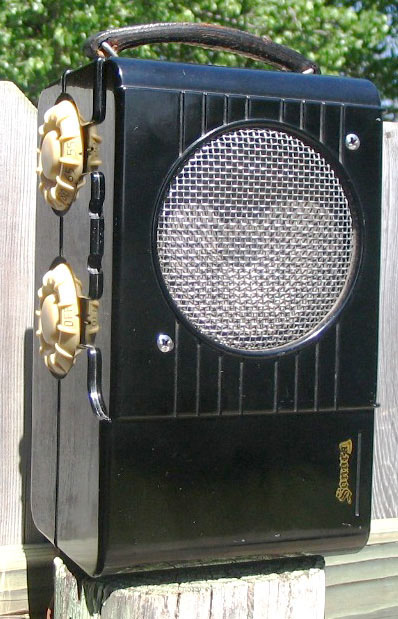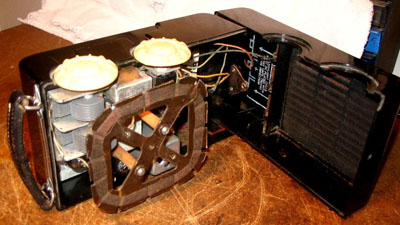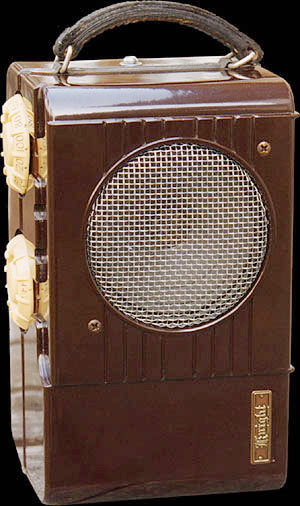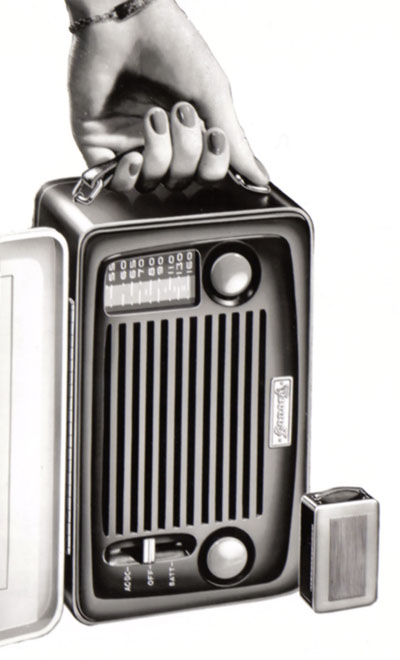Of Old Radios And Related Items--Published Monthly
Sonora's First Plastic Portable Radios
The Sensational CandidBY RICHARD ARNOLD
Web Edition
The Sonora Company continues to be one of Richard Arnold's radio interests. (See his A.R.C., July 2008 article). Here he describes the company's first plastic portables. (Editor)
In 1939, the new portable radio craze was sweeping the nation, and my Sonora KG-80, shown in Figure 1, is a good example. Radio Guide Magazine of September 22, 1939, illustrates some of the typical advertising for these new portables: "'She shall have music wherever she goes' is the last line of a pure piece of Mother Goose imagery which has come magnificently alive during the past year with wide public acceptance of the portable radio, little giant of the airwaves. Now one can not only have music wherever one goes, but also news of the great war, drama, and the hundreds of other daily features which were foregone whenever the listener happened to leave an electric connection.
"It is no longer uncommon to see strollers, with a tiny portable strung over their shoulders, listening as they walk. (Figure 2 (see print version) shows an advertisement for some portables.)
"Two reasons may be given for the new popularity of the portable. The first is that radio entertainment has become so much a part of the average life in America that we are unwilling -- during those periods when we must be away from our living-rooms -- to miss the grand entertainment this industry offers. The second reason is the new efficiency of operation which has been built into these midget, self-powered sets, plus the reduction in their costs to meet public demand."
Figure 1. Richard Arnold's Sonora Model KG-80 Candid photographed posing on a fence post. The Sonora logo is on the lower right.I do not have Sonora's portable production figures, but I do have Emerson's portable production figures just to show you how popular the portable had become. Emerson said that its portable radio production jumped from 850,000 sets in 1939 to 1,570,000 sets in 1941, and that this was another example of public preference for small radios.
In 1940, Sonora was busy introducing two of its very first plastic radios. They not only came out with the Model KG-80 Candid portable, but also introduced about the same time the "Gem" covered in my July 2008 A.R.C. article.
The Candid Model KG-80
Of the four Sonora Candid models discussed in this article, the first is the 1940 Model KG-80 Candid shown in Figure 1. In 1939, plastic was becoming the logical replacement for wooden radios. A plastic radio could be made two to three times more cheaply than a wooden set.
In June of 1940, The Durez Molder, a company publication of Durez Plastic & Chemicals Company of North Tonawanda, New York, published an article on the new Sonora portable. This company furnished the plastic compounds for the Sonora Candid and Gem radios.
The company's glowing description of the new radio in part reads: "Another new Sonora model -- the 4-tube "Candid" portable radio has a Durez housing. Naturally, portable models have to be engineered to
take a little extra abuse. By clever design coupled with plenty of experience in plastics, the Sonora engineering division has turned out a very attractive, serviceable unit. An extra-strength Durez Phenolic molding compound has been employed to give rigidity and long life to the housing."
The KG-80 Candid was molded for Sonora by the Richardson Company located in Melrose Park, Illinois. It was styled like a camera and measures only 8.4 x 5 x 4.4 inches. Weighing in at 4.5 pounds, it has a leather handle attached to nickel-plated metal trim. It has no external aerial or ground, but has a built-in Sonora "Air Magnet," shown in Figure 3, making it entirely self-contained and self-operating.
Volume and tuning controls are set into the side of the case. These are the early knobs and do not have the word "Sonora" on them. They are of a molded plastic material and are in an ivory color. They contrast nicely with the shiny black color of the radio cabinet.
Figure 3. The KG-80 Candid shown open so the "Air Magnet" loop antenna can be seen.Miss Virginia Burpo, who was an assistant Sonora designer, designed the Sonora knobs that were used on the Sonora Candid and the Gem. She was later to become the wife of PWC, the designer of all Sonora models from 1939 to 1943.
The KG-80 Candid is a 4-tube superheterodyne circuit radio. It uses three D-cells and one 45v battery. It loads almost like a camera opening down the center with a clip-in arrangement for the batteries. It was the first radio to use the new small tubes by RCA. It actually beat out the RCA BP-10 for this honor by a couple of months. The tubes used in the radio are Types 1R5, 1T4, 1S5 and 1S4.
The Candid also has a provision for plugging in headphones, which automatically silences the speaker. A single headphone and a shoulder strap were optional features.
The Model KG-80 Candid tunes a standard broadcast band of 535-1720 KC and covers the police band. The radio uses a 4-inch PM speaker. It also has a metal grille cloth.
Inside the cabinet, the KG-80 Candid has a sticker that says that it was made at the Plant A in Chicago, as shown in Figure 4 (see print version). Plant A was the Clinton Manufacturing Company of Chicago.
Other Candid Models
Sonora apparently sold the Candid design to Allied Radio, which came out with its own model of the Candid in 1940. It uses the same RCA tubes and is designated the Model B10506, shown in Figure 5. The Knight version of the Candid does not have a plant sticker.
Figure 5. The Allied Radio version of the Sonora Candid radio, the Model B10506. The Knight logo is on the lower right. (Photo courtesy of John Pelham of Radiophile.com)In 1941, Sonora came out with another adaptation of the Candid called the Model KG-132 "Brownie." This model is the same as the original Candid in that it also tunes a standard broadcast band of 535-1720KC; however, it is housed in a "warm, walnut brown," plastic case. Refer back to Figure 2 (see print version) for an illustration of the KG-132.
There are two other Candids that probably no one has ever seen or heard of. They are the Models LP-161 and LP-163, shown in Figure 6 (see print version). These sets came out in 1942, and they are quite different from the original Candid and the Brownie.
Sonora tells about the Models LP-161 and LP-163 in the 1942 sales brochure: "Here is the personal touch in radio -- masterfully designed by Sonora in two of the most delightful versions you've seen yet.
Figure 7. A copy of the original photograph of the Model LP-161 used in the 1942 catalog.Works like a charm, not only from self-contained batteries, but from an AC or DC electrical outlet as well -- jewel-crafted, jaunty, just the radio to play as you go or to enjoy at home."
The Model LP-161 has a two-tone plastic case. According to Mr. PWC, the Sonora Company cabinet designer, this model may have been the first radio cabinet molded from a thermo plastic material. A copy of the original photograph used by Sonora in its catalog is shown in Figure 7.
This radio cabinet was made by the Richardson Company, makers of injection molding machines for molding knobs and circular parts. This Candid project used the company's first molding machine large enough to mold a rectangular part of this size, and they offered to solve the Candid molding problems without cost to Sonora.
The Model LP-163 Candid is the same as the Model LP-161, except that instead of a two-tone plastic case, it was offered in a deluxe version. It is styled in genuine top-grain cowhide leather with a rich Florida tan finish. Both sets have a hinged door and an exclusive new slide-rule dial that tunes the broadcast band from 535 to 1650 KC.
Always a welcome addition to a collection in order to document the history of radio is the shipping box. Figure 8 (see print version) shows the box for a Model KG-80 Candid. Even on the box, Sonora touted its slogan, "Clear as a Bell."
In the years 1940-1941, Sonora was producing more radios than ever before. They had a range of products which seemed to cover all tastes and pocketbooks.
Then in 1943, in the middle of the war, military men in uniform came into the Sonora plant and ordered all who did not have a security clearance to leave the building. Mr. PWC and his wife, who were both company designers, did not have the required clearances and had to leave the company. This was a sudden and surprising end to a smoothly working organization.
Photo credit and information for Knight radio: John Pelham of "Radiophile.com."
References:
Durez Molder, company magazine, Durez Plastics and Chemicals, Inc., North Tonawanda, N.Y., October 1940.
Emerson Radio and Phonograph Corp., New York, N.Y., December 1943.
Listen America, Sonora Radio and Phonograph Catalog, 1941.
Mr. PWC, Sonora's company designer from 1938-1943.
Radio Guide Magazine, September 22, 1939.
Small Radio Yesterday and in the World of Tomorrow. New York: Emerson Radio and Phonograph Corp., 1943.
Richard Arnold, a frequent contributor to A.R.C., has been collecting radios since 1985. His interest is primarily in cathedrals and 1920s battery sets, and his collection ranges from crystal sets to a 1928 Bosch in a Pooley cabinet. His prize is the 1932 Jackson Bell Peter Pan featured in the June 1991 A.R.C.
|
[Free Sample] [Books, etc., For Sale] [Subscribe to A.R.C./Renew] [Classified Ads] [Auction Prices] [Event Calendar] [Links] [Home] [Issue Archives] [Book Reviews] [Subscription Information] [A.R.C. FAQ]URL = http://www.antiqueradio.com/Aug09_Arnold_Sonora.html Copyright © 1996-2009 by John V. Terrey - For personal use only. Last revised: August 7, 2009. For Customer Assistance please contact ARC@antiqueradio.com or call (866) 371-0512 toll free Antique Radio Classified |



